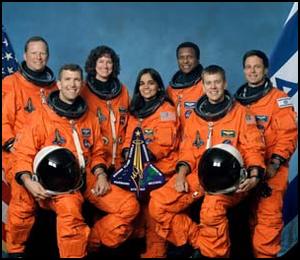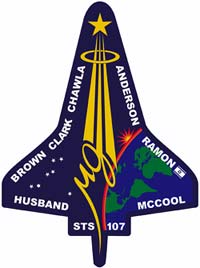|
On the 1st February 2003, space shuttle Columbia
fell from the sky. It was NASA's worst disaster for 17 years.
Should flight STS107 have launched at all?
by Stuart Carter and Nigel Henbest
Today’s shuttle system is outmoded
and costly. It is also potentially lethal. Space Shuttle Columbia
disintegrated into thousands of pieces as it fell to Earth, killing
all seven crew. Was this a freak accident or a disaster waiting
to happen?
We need to look beyond the immediate technical
failings of flight STS 107 and uncover the truth about compromises
made in the shuttle design over 3 decades ago. In the early 80s,
the space shuttle system was widely hailed as the ultimate access
to space. In fact, its design is flawed – and that may have
led to two disasters. The design is an awkward muddle of civilian
and military requirements, further confused by politicians and budgets.
It’s a compromise that dates back to the height of the cold
war.
In the 1960s, America won the space race by
getting to the Moon before the Soviet Union. But it wasn’t
cheap. With every flight, NASA had to build a giant, disposable
Saturn 5 rocket. Hundreds of millions of dollars of equipment were
thrown away every time a mission was launched. NASA’s dream
was to build a reusable launch vehicle, which would make space flight
cheap and commonplace. NASA’s original plan was for a small,
lightweight vehicle that could be flown into space on top of a fully
reusable, piloted aircraft. The shuttle would peel off into orbit
as the winged fuel tank flew back down to earth. NASA had wanted
to build the ultimate dream space vehicle – but what they
got was a jumble of tanks and rockets with an aircraft (the Orbiter)
stuck on the side.
To escape the Earth’s gravity, each Orbiter
has to carry over half a million gallons of fuel in an enormous
External Tank. Even though it’s burning one and half tons
of hydrogen and oxygen every second, the Orbiter is still too heavy
to blast off from the ground. For extra lift, two powerful rockets
are strapped to the side – the Solid Rocket Boosters. Lift
off is the most dangerous time to be on a rocket. With so much explosive
energy around things can go violently wrong. And solid rockets add
to the potential danger: unlike liquid-fuelled rockets, once you’ve
lit the blue touch paper, they can’t be switched off.

STS107-S-002
(October 2001) - The seven STS-107 crew members take a break
from their training regimen to pose for the traditional
crew portrait. Seated in front are astronauts Rick D. Husband
(left), mission commander; Kalpana Chawla, mission specialist;
and William C. McCool, pilot. Standing are (from the left)
astronauts David M. Brown, Laurel B. Clark, and Michael
P. Anderson, all mission specialists; and Ilan Ramon, payload
specialist representing the Israeli Space Agency.
We
remember them.
|
When Columbia blasted space-wards on
the very first shuttle mission in 1981, NASA continued the tradition
of safety first - the two-man crew had the benefit of ejector seats
built into the cockpit. But by the fifth shuttle launch, ejector
seats were removed, for good. For the first time in American space
history, crews were being blasted into space with no way of escaping
from a launch emergency.

Space Shuttle
Columbia STS-1 lifts off from Complex 39A of the Kennedy
Space Center during the first launch of the
space shuttle in 1981
|
When NASA had first proposed their
plans for a space shuttle, they were going to need big money to
get it off the ground. This was the era of Richard Nixon. He appeared
to be a space enthusiast but the reality was rather different. The
only way NASA would get their shuttle was if they co-operated with
the Department of Defense. The CIA and the US Air Force were pushing
for a large payload capacity, big enough to house their 60 foot
spy satellites. But a large payload bay meant a heavy vehicle -
and a heavy vehicle requires more power and fuel for lift off. NASA
was also under pressure from Nixon’s Office of Management
and Budget. This began a decreasing spiral of short-sighted cost-cutting
measures. One proposal suggested doing away with the reusable launch
vehicle. Instead, the system would use a disposable liquid fuel
tank and 2 solid rocket boosters.
Initially NASA dismissed the idea out of hand
- it might be cheaper in the first instance, but it would add to
the cost of each successive flight. But when the Office of Management
and Budget heard of this design, they insisted NASA accept it. Still
sceptical, NASA researched the failure rate of solid fuelled rockets
and identified one potential weakness: hot gas burning through the
rubber O-ring seals at the joins between segments of the solid rocket
boosters. Their fix was to use two sets of O-rings for safety. But
still, it wasn’t enough

Challenger
STS-51L Explosion - Hurtling out of the conflagration at
78 seconds are the Challenger's left wing, main engines
(still burning residual propellant) and the forward fuselage
(crew cabin).
|
On a frosty January day in 1986, as
Challenger was about to launch, the O-rings were frozen stiff with
the cold. Two minutes after lift-off, at 48,000 feet, hot gases
leaking from the faulty seal burnt through the connecting struts.
In an instant, the fuel tank exploded. With Challenger, the flawed
design of the Space Shuttle system had claimed its first seven victims.
NASA’s initial fears had come true. Since
the Challenger disaster, every shuttle astronaut flies equipped
with a pressure suit and a parachute so that they can bail out in
an emergency.
But NASA’s problems with the shuttle continued.
In May 1995 the launch of Discovery had to be abandoned when woodpeckers
pecked 200 holes into the foam coating on the fuel tank. To scare
them off, NASA employed a foghorn - and six life-size owls, bought
from the local Wal-Mart. And when Atlantis launched in October 2002,
eyewitnesses reported insulating foam falling from the fuel tank
during lift off. It severely dented the skirt on one of the Solid
Rocket Boosters. But NASA reckoned the foam was not a danger and
there was no real attempt to stop it happening again.
When Columbia launched in January 2003 and foam
again fell from the tank, NASA engineers examined film footage of
the falling debris hours later. There seemed little cause for concern.
Crucially, the original shuttle design would have avoided this problem
altogether - the Orbiter would have had much smaller wings and sat
in front of any falling debris. The exact reason why Columbia disintegrated
is still a mystery, but damage to its wing during launch remains
at the heart of the investigation.
And any damage to the Orbiter could
prove fatal to the crew during the critical few minutes of re-entry.
Again, the compromise design of the shuttle system laid its crew
open to danger. Originally, NASA’s ideal space craft was a
small orbiter with stubby wings - similar to the X15 rocket plane
of the 1960s. But, starved of funds by Nixon’s administration,
NASA had to share its dreams with the military. And they had their
own ideas. The Pentagon’s dream machine was delta-winged,
capable of gliding long distances from its main orbital path. But
this design presented NASA with a new challenge. The old style capsules
only had to withstand the inferno of re-entry for 4 minutes. But
the shuttle, with its delta wings, glides back to earth at a much
slower, shallower angle, so its ‘hot’ period lasts more
than 12 minutes. And the underside area exposed to re-entry is far
greater than their original smaller space-plane.

The X-15
|
NASA was faced with developing a totally new
heat shield - something both light and re-usable. They opted for
a jigsaw of ceramic tiles. Right from the inception, the tiles were
the shuttle’s greatest weakness.
NASA blasted the first shuttle Columbia into
space in 1981. But in orbit, the crew reported the loss of several
tiles. Luckily they weren’t in a crucial area. But the loss
of any tiles exposes the airframe to the dangerous hot gases of
re-entry. On the 16th January 2003, the crew - under the command
of Rick Husband - prepared to launch on Columbia’s 28th mission.
For four of the astronauts, this would be their first flight into
space. As Columbia blasted into orbit, NASA’s cameras tracked
the launch. They recorded foam insulation hitting the leading edge
of the left wing.
This came as no surprise to independent consultant
Paul Fischbeck. He had already published a report showing that in
27 previous launches falling debris had caused damage to thousands
of tiles. But the debris that hit Columbia this time was bigger
than anything Fischbeck had seen before.
After 17 days in orbit, the crew prepared Columbia
for re-entry. On the 1st February at 7.50am the orbiter punched
through the upper atmosphere. Travelling 25 times faster than the
speed of sound, the plasma shock-wave began heating the underside
of the orbiter. With the temperature’s reaching over 1600
degrees Celsius, the only thing between the crew and the extreme
heat of re-entry was the fragile silica tiles. As Columbia roared
through the atmosphere, mission control monitored the re-entry.
Data from the shuttle began to show abnormal temperature rises inside
the left wing.
In less than 5 minutes it climbed by more than
60 degrees. The internal structure of the Shuttle’s wings
are made up of hundreds of aluminium cross members wired with thousands
of heat sensors. These struts bear the load of the wing –
giving it rigidity for the high stresses of launch and re-entry.
If the leading edge had been damaged during launch, hot gases might
be able to blast into the wing cavity.

The Insignia
of the STS-107 Crew
|
We now know that 5 pieces of the Orbiter
broke off over California. As the shuttle began to break up its
wreckage spread over thousands of square miles. The small town of
Nacogdoches in Texas was directly in the line of fall out. Reports
began to come in that pieces of debris were literally falling out
of the sky. Some of them clearly segments of the heat shield. A
massive recovery operation got under-way. NASA wanted answers. The
mystery as to why the shuttle broke-up could lie in any one of these
pieces of wreckage.
What we do know is that data reveals that in
the last few seconds the pilots may have been fighting to switch
off the autopilot and get the shuttle under manual control. So was
this horrendous accident avoidable? Could NASA have investigated
the possible damage to the wing more thoroughly before re-entry?
And how can they prevent future tragedies?
Even before the Columbia accident, NASA was
starting to look for a future shuttle replacement. Ironically, some
of the design concepts are looking more like their original vision
from the early 1970s - a smaller stubbier winged Orbiter, mounted
above the launch system. Whatever the final design, this tragedy
must lead to a safe and reliable launch system that matches the
bravery of the humans who willingly face the dangers of space.
|
